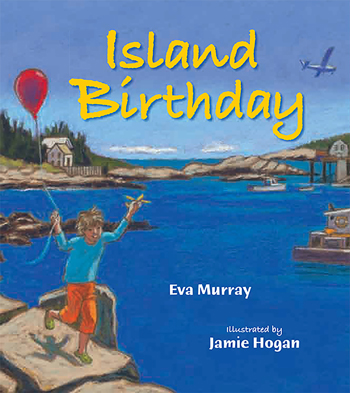B O O K R E V I E W
Living Island Style
by Kayla Crowe

Island Birthday
By Eva Murray
Tilbury House Publishers
Thomaston, Maine
www.tilburyhouse.com
$16.95
Living on an island, it seems like the people are more dependent on each other for little things. From the first page of Island Birthday that is apparent with a little thing like milk. The drawing on that page depicts something most kids have done and most parents have heard as the main character, young Riley, yells out to the household that they are out of milk, again!
Residents are also dependent on postal service to get things people on the mainland can get at the local store, such as dog food, which is described on page 12. There is a text reference to being “almost out of dog food.” The drawing, however, although picturing a dog, is more about the main character Riley, running into a neighbor, and although the conversation touches on dog food, it is more about one of the natural curiosities found along the beach.
This island’s residents are also often dependent on the small plane that delivers many of the things the island needs from the mainland, including occasional transportation. Weather often interrupts service and when a special occasion coincides with interrupted service it can heighten the stress of that dependence. That connection to others on the island and to what is on the mainland is the theme of Island Birthday.
The author, Eva Murray, has lived, taught school, married, raised her children, written for several publications and run a small business on a small, remote island. Her text is compact, and Jamie Hogan’s illustrations are exquisite. Hogan’s drawings capture the readers’ eyes and draw them into the story. She brings scenery, the characters in the story, and the visual details of everyday objects to life on every page.
The drawings alone, done in pastels, give the reader a good idea of what is going on in the story. The realism of the people, great colors, shading, and accuracy of the depth of field are all great, as are details such as eye expressions.
Hogan’s drawings reflect exactly what Murray has written—so closely that some readers, and certainly very young, beginning readers, may get more of the emotion from the faces of characters and details of the story than the text. The faces express curiosity, happiness and thoughtfulness. The details in the eyes, the wind-blown hair, dark clouds giving way to clear skies, a reflected object in sunglasses or in a truck mirror—these are all nuggets left for the curious reader to discover and add to the pieces of the visual and written puzzle. A great example is a drawing of Riley and a woman on her lobster boat. Both have paused to listen through the wind for what they hope is the long-delayed plane. The tiny plane reflected in the woman’s sunglasses is the clue that they have heard the plane overhead.
Murray’s story is one that most readers can relate to. She captures the sense of being excited about a special occasion and the anticipation of that occasion. Woven into the concern that it may not arrive are the thoughts, concerns and feelings of many young people who live a unique life in a unique environment and community on islands. Riley complains that he wishes he lived on the mainland where he could live a “normal” life. In the end, things work out for Riley. He is showered with the friendship and the tight community of island life and the realization that brings to him.
